
On 12 March 1930, Gandhi and 78 satyagrahis, among whom were men belonging to almost every region, caste, creed, and religion of India, set out on foot for the coastal village of Dandi, Gujarat, 390 km from their starting point at Sabarmati Ashram. The Salt March was also called the White Flowing River because all the people were joining the procession wearing white khadi.
The news of his progress, his speeches, huge crowds that greeted and followed the marchers, people spinning Charkas to show support, officials resigning from their posts to respond to Gandhiji’s appeal, was carried every day by the newspapers throughout the country. Congress workers also played an important role to spread the news of Dandi march throughout the country. On 6th April 1930, when Gandhiji finally reached Dandi entire nation was expectant and restless about Gandhiji’s final action. Like a ritual beginning of Civil Disobedience movement on 6th April 1930, Gandhiji by picking up a handful of salt inaugurated the movement. A movement which would change the course of freedom movement by the sheer weight of mass participation that it exhibited.
Picture Credit : Google




